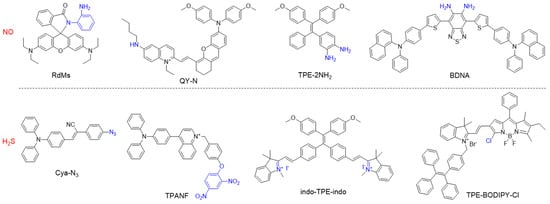Precision medicine requires highly sensitive and specific diagnostic strategies with high spatiotemporal resolution. Accurate detection and monitoring of endogenously generated biomarkers at the very early disease stage is of extensive importance for precise diagnosis and treatment. Aggregation-induced emission luminogens (AIEgens) have emerged as a new type of excellent optical agents, which show great promise for numerous biomedical applications. AIn this review, we highlight the recent advances of AIE-based probes for detecting reactive species (including reactive oxygen species (ROS), reactive nitrogen species (RNS), reactive sulfur species (RSS), and reactive carbonyl species (RCS)) and related biomedical applications are introduced. The molecular design strategies for increasing the sensitivity, tuning the response wavelength, and realizing afterglow imaging are summarized, and theranostic applications in reactive species-related major diseases such as cancer, inflammation, and vascular diseases are reviewed.
- aggregation-induced emission
- reactive oxygen nitrogen species
- activatable probe
- theranostics
- fluorescence
- photoacoustic
- afterglow
- bioimaging
1. Introduction
2. Detection of Reactive Oxygen Nitrogen Species
When designing a specific chemical/biological probe, a usually requisite is to synthesize molecules with specific recognition groups or moieties.The boronate subunit is a popularly used building block for H2O2 sensors, as the boronate cage is nonfluorescent and the conversion of arylboronates to phenols results in turn-on emission [95][96][97][95,96,97]. The deprotonated H2O2 is a potent nucleophile, which can attack the boron center to generate a labile borate species that hydrolyses to the corresponding phenol [98]. For O2•− detection, the diphenyl phosphinyl group can be introduced into an organic compound, in which the fluorescence is strongly quenched at first, and obvious turn-on fluorescent signal is realized in the presence of O2•− [99][100][99,100]. The oxidative properties of ClO− can be utilized to destroy C=C or C=N bonds rapidly, therefor, the conjugation of fluorescence quencher through C=C or C=N bonds has turned out to be an efficient strategy to construct ClO− probes [101][102][101,102]. Some arylboronate groups, diphenylphosphinate groups, and nitrophenyloxoacetamide moieties have been employed as the response substitutes for ONOO− detection [103][104][105][103,104,105]. The tunability of molecular structure will alter the photophysical properties and biomedical applications as well. H2O2 is an overexpressed molecule in many serious diseases, and thus, it is regarded as a pivotal biomarker for some biological processes and disease diagnoses [106][107][108][106,107,108]. A variety of H2O2-activatable probes have been exploited based on AIEgens, which exhibit excellent performance for both in vitro and in vivo applications [109][110][111][112][109,110,111,112]. Xia and Lou et al. developed a H2O2-responsive AIEgen for peroxidase-mediated selective imaging and inhibition of inflammatory cells [113].The probe consisted of a TPE core and two tyrosine (Tyr) moieties, which could undergo enzyme-catalyzed dityrosine formation in the presence of peroxidase and H2O2. By conjugating two hydrophilic Tyr groups, the hydrophobic TPE molecule became hydrophilic TT, which showed weak fluorescence in aqueous solution due to the excited-state energy consumption via intense molecular motion. As a result, the H2O2-responsive and myeloperoxidase (MPO)-mediated TT self-assembly enabled turn-on fluorescence, which could be used for selectively imaging and inhibiting inflammatory cells containing overexpressed H2O2 and MPO. The AIE process could be activated through dityrosine linkage-induced hydrophobic aggregates formation, which helped to distinguish between inflammatory and normal cells. Additionally, the in situ formation of TT aggregates could inhibit RAW264.7 cell growth through inducing mitochondria damage and cell apoptosis. Wang and Li et al. reported a ROS-responsive theranostic nanoplatform for accurate diagnosis and therapy of inflammation diseases [114]. A two-photon AIEgen (TP) was conjugated with the widely used anti-inflammatory glucocorticoid, prednisolone (Pred) with the ROS-sensitive linkage to afford the compound TPP. Then, the TPP was encapsulated with an amphiphilic block copolymer PMPC−PMEMA (PMM) to give polymeric micelles (TPP@PMM). Noteworthy, the PMEMA part served as the hydrophobic block in the NPs formation, which could be oxidized in response to ROS to yield the hydrophilic sulphone product. The ROS-triggered hydrophobic-to-hydrophilic conversion was able to realize ROS-mediated drug delivery at an inflammatory site. This shell-core dual ROS-responsive nanoplatform was used in three different inflammatory murine models including acute lung injury, atherosclerosis, and arthritis. The deep-penetration two-photon fluorescence diagnosis and efficient serial ROS sensitive anti-inflammation could be used for both acute and chronic inflammation theranostics. Two-photon imaging with the AIEgen helped to provide unambiguous delineation of inflammatory tissue with minimum autofluorescence interference. Moreover, TPP@PMM also possessed excellent anti-inflammatory effect that reduced the inflammatory response and decreased inflammatory cytokines expression.3. Detection of Gasotransmitters
Small gaseous molecules including NO, CO, and H2S, function as important signal transmitters in living systems as they are associated with many biological functions and major diseases [115][116][117][118][148,149,150,151]. NO is a neutral diatomic free radical that is produced from L-arginine by NO synthase (NOSs) isoforms such as neuronal NOS (nNOS), inducible NOS (iNOS), and endothelial NOS (eNOS) [119][120][152,153]. CO is the second gasotransmitter that is generated as a byproduct of haem cleavage by two distinct haem oxygenases [121][154]. H2S is predominantly formed from Cys or its derivatives by the enzymes cystathionine β-synthase and cystathionine γ-lyase [122][155]. All these gasotransmitters play vital roles in vasorelaxation and inflammatory responses, thus, numerous molecular probes have been developed for precise monitoring of related diseases [123][124][125][156,157,158]. For example, the o-diamino aromatic moiety is a recognition group for NO, and the cyclization reaction of o-diamine with NO produces a triazole moiety, which alters the electronic property and conjugation nature [126][127][128][159,160,161]. For H2S detection, the popularly used approaches include reduction of azides into amines and nucleophilic addition of H2S to the electrophilic group [129][130][162,163]. Some representative AIEgens for sensing gasotransmitters are listed Figure 13, which show great potential for applications in biological imaging and disease diagnosis.
